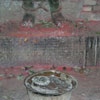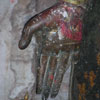On The Antiquity of Nepalese Metalcraft: The Buddha of Guita Bahi
- click on the image to enlarge | click on the image again to enlarge further
click Esc or X to close and return to this page
Figure 4: Śākyamuni Buddha
The main deity of Prathama Śrī Mahāvihāra (Prathamaśrī mahāvihāra gandhurī devatā)
Cast Copper with traces of gilding, with gilt repousse copper covering removed, but repousse sleeves on left and right arms still in place; note the crown to the left of the base.
h. approx 6 ft 8 in (Vajracarya, Herakaji, 1999, p 53)
Nepal, 542 CE (?).
Photo: Ian Alsop, Feb. 4, 2008
Details: see thumbnails below
Detail 1, another view, photo Vajra Alsop, Sept. 7, 2019
Note here the repousse sleeves covering the shoulder have been removed, but the forearms are still covered.
Detail 2, body, photo Ian Alsop, Feb. 4, 2008
Detail 3, pedestal and feet, photo Ian Alsop, Feb. 4, 2008
Detail 4, right hand, note that most of the little finger is missing; photo Ian Alsop, Feb. 4, 2008
Detail 5, base closeup, photo Ian Alsop, July 30, 2010
Citations; Published: (with repousse covering):
Slusser, Mary Shepherd, 1982, Nepal Mandala, two vols. (Princeton, New Jersey: Princeton University Press), vol. 2, plates 485, 486
Dīpaṇkara Buddha, copper repousse 13th c. (?)
Vajracarya, Herakaji, 1999 (N.S. 1119) Guitaḥyā Bahi Vihāra Sangh (Gustala Mahāvihāra, Prathamaśrī mahāvihāra, Vasuccaśīla Mahāvihāra chagu adyayana (A study of the Guita Bahi vihāra Sangha) (Dipavatī Putsakālaya, Guita, Patan), 2nd fig before p. 1, The main deity of Prathama Śrī Mahāvihāra (Prathamaśrī mahāvihārayā gandhurī devatā)
Michaels, Axel, 2013, " From Syncretism to Transculturality: The Dīpaṅkara Procession in the Kathmandu Valley" in Hüsken/Michaels, editors, South Asian Festivals on the Move, (Hüsken/Michaels,South Asian Festivals on the Move (Wiesbaden: Harrassowitz Verlag), pp 317-342. Fig. 2: The Guitah Dīpaṅkara Buddha at Guita Bahā, 13th cent. (photo: Manik Bajracharya, 2002)





